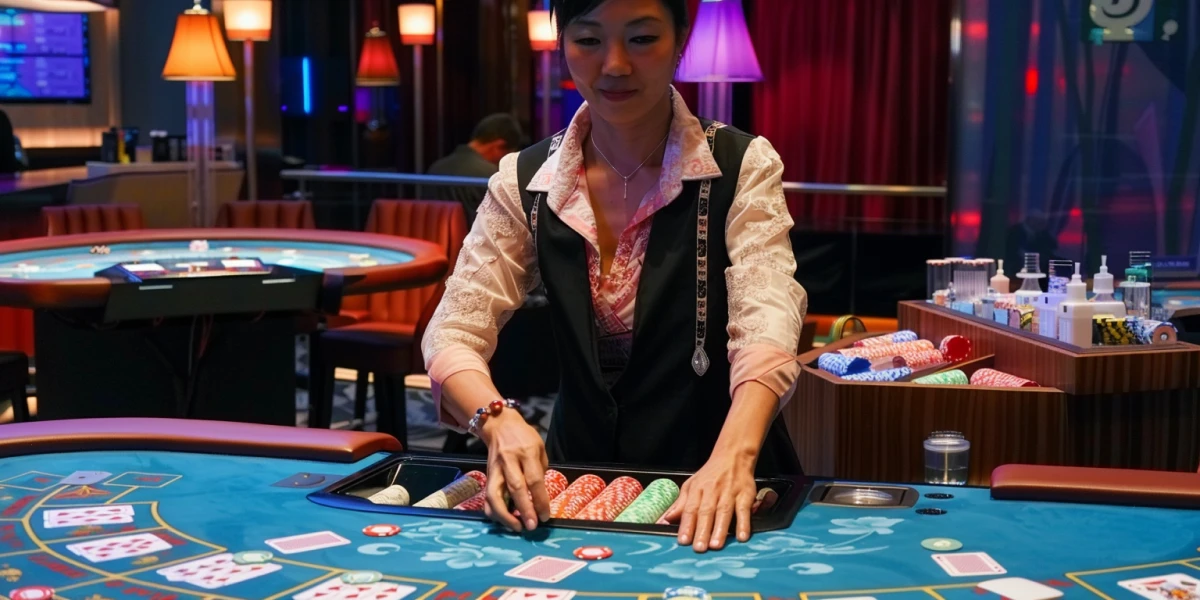What You Need to Know about Pai Gow Poker for Poker Enthusiasts


1.0
Default
If you’re a pro at Texas Hold’em, exploring other types of poker games can be a great way to build your poker skills. There’s a sense of pride when you’re able to master a whole new game and find ways to win good money. While popular variations of poker like Omaha and Two Card Stud continue to be go-to games, there’s another interesting variant that often flies under the radar—Pai Gow Poker.
Pai Gow Poker combines elements of the ancient Chinese game of Pai Gow and traditional poker, creating a unique and strategic game that’s gaining popularity in casinos across the US. If you’re interested in working on your casino gaming skills, read on to figure out the basics, explore your gaming options, and learn a new poker variation you could play with your friends and colleagues.
Pai Gow Poker is another kind of table game with American and Chinese origins. It was first played in the US in the 1980s. Sam Torosian, the proprietor of a card club in California, created the game by transforming the traditional Chinese domino game Pai Gow into a card game. His creative tweak blended the original Pai Gow's framework with conventional poker hand rankings. Pai Gow Poker is already a mainstay in casinos all over the world, despite being a relatively new game.
Remember that the objective of Pai Gow Poker is to create two hands—a five-card hand and a two-card hand—that both beat the dealer's corresponding hands. Your five-card hand should be stronger than your two-card hand, so careful strategy is key. It’s a game of skill and luck, offering a unique twist for poker enthusiasts looking for something different.

The dynamic of this type of poker begins with a seven-card hand. Players must arrange seven cards to form two hands which are usually hands that are composed of five cards and then two cards, totaling a seven-card hand. Keep in mind that the five cards should have a higher ranking than the two other cards.
If you’re playing virtual Pai Gow poker, you’ll find the dealer shaking up the dice cup which holds the three dice that will determine the player’s stake in the game. Regardless of whether a player is present or not, the Pai Gow dealer will deal the seven hands—each comprising seven cards—clockwise to each position after counting counter-clockwise from the Banker position (number one).
If you want your hand to be set based on the “House Way,” then the dealer can simply reset it for you. The Dealer will reveal the Banker's hand once all Players have established their hands. The Banker's hand is then compared to each Player's hand, and wagers are made after the Dealer sets the Bank hand by the "House Way."
With seven cards, each player at the table will form two hands: a five-card hand and a two-card hand. So the players' responsibility is to set their own hands, and they ought to do so carefully. It is always necessary for the five-card hand to have a higher poker rank than the two-card hand.
A two-card hand that is positioned higher than the five-card hand, or a hand that has more or fewer cards than the required number, will be fouled, and a Supervisor will need to be alerted. In the event of a fouled hand, the Supervisor or Pit Manager will decide.

The dealer will reveal and set the House Hand after all player hands have been set. The House Hand will always be arranged in accordance with the "House Way," which calls for placing it parallel to the bankroll rack in a left-to-right declining order of value. The five-card hand that is closest to the rack will be positioned about an inch from the edge. The two-card hand will be arranged in declining value order, parallel to the rack, and positioned above the five-card hand. Aligning both hands with the money rack's left edge is the goal.
After the dealer has set their hands, it's time to check each player's hand against the dealer's. You win if both of your hands are better than the dealer's! Should one hand prevail, it's a push, and your initial wager is returned. However, you lose if the dealer's two hands are better than yours. The technique is clear-cut and easy to understand, which keeps the game running smoothly. So take a seat back, watch the dealer at work, and cross your fingers that your hands win!
Now, if you’re looking for a more challenging yet exciting Pai Gow poker round, progressive Pai Gow might be one option to consider. Except for an optional Progressive Wager side bet, Progressive Pai Gow Poker is exactly the same as standard Pai Gow Poker. A player wagers that they will be able to form a qualifying five-card poker rank hand out of the seven cards they are dealt when they place the progressive wager.
Regardless of how the Player arranges their seven cards, the Progressive Wager receives an odds payout based on the rank of the five-card poker hand. The Player will still be compensated for the Progressive Wager even if they choose to split a full house, five Aces, straight flush, etc.
The way dealers deal cards for Pai Gow Poker can be really intriguing. The dealer shuffles the cards and arranges them into seven face-down piles, one for each player and the dealer, plus four unwanted extras that are thrown into the discard pile, also known as the muck.
In fact, the dealer shuffled the cards into heaps and fashioned them into the shape of a dragon with a head, body, and tail before the invention of card shufflers. From one to seven, each seat has a number, starting with the banker. The dealer deals cards counterclockwise, selecting a number at random to determine who is given cards first.
Take your poker skills for a spin in this thrilling variation on the traditional game and discover the dynamic of Pai Gow poker. It's similar to dominoes and Texas Hold'em, with the opportunity to quadruple your winnings! Chinese dominoes are used in Pai Gow instead of cards, but your knowledge of hand rankings and bluffing strategies will come in helpful. Now, take a seat at the table and try to master this special fusion of skill and luck.
Learn more about online poker and how to further improve your hand from our resources at GambleSpot today.

July 26th, 2024
7 Best Horses that Made A Name in Horse Racing
July 24th, 2024
The Role of the Banker in Baccarat - and Why This Could Sway Your Odds
July 19th, 2024
5 Best Slot Games for Art Lovers to Feast Their Eyes on
July 16th, 2024
Fact or Fiction: Pai Gow Edition – What First-time Players Should Watch Out For
July 15th, 2024
Tech and Horseracing: What to Know about Digitizing the Horsebetting Experience
July 9th, 2024
5 Online Casinos with Less than $20 Minimum Deposit You Should Check Out in 2024
July 3rd, 2024
Debunking Common Lottery Myths: What First-time Bettors Should Know
July 2nd, 2024
What to Know About the State of Michigan and Online Poker in 2024
July 1st, 2024
Debunking Common Baccarat Myths: Why You Should Know Better
June 27th, 2024
Understanding the Legal Aspects of Horse Betting in the US: What to Know in 2024Are you sure?
This will delete all chat history, and I will not remember what we were talking about.
✔
Todays Hot Deals